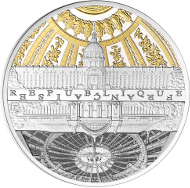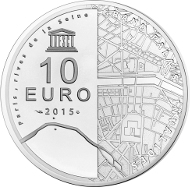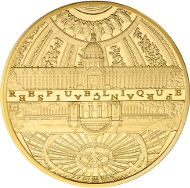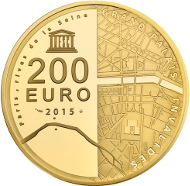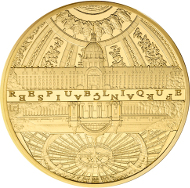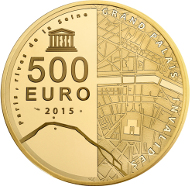February 5, 2015 – For more than 40 years, the UNESCO (the United Nations Educational, Scientific and Cultural Organization) lists the sites that are part of the “world heritage cultural property sites”.
The aim of this program is to classify, name and preserve the cultural goods and natural assets that matters for the common heritage of humanity.
This program was founded with a Convention adopted by the General Conference of UNESCO on September 16th, 1972. in 2013, over 981 sites in 160 states are registered.
From 2014: A new site: The Bank of the Seine
Since 2007, Monnaie de Paris pays tribute to these unique sites in a collector coin series. From 2014 on, a new leaf is turned in this series, that will be dedicated over several years to one of the most famous sites in France: the Banks of the Seine in Paris.
Each year, monuments sites within the site’s delimitation will be honored, and a common reverse for this series will help visualize the location of each monument on a Paris’ map.
FRANCE / 10 Euro / 2015 / Silver Ag 900 / Diameter: 37mm / Weight: 22.2 g / Proof / Mintage: 5.000.
From the Louvre to the Eiffel Tower, from Place de la Concorde to Grand Palais and Petit Palais, a lot of Paris historical evolution can be seen from its river. Notre-Dame Cathedral and the Holy Chapel date back to the Middle Ages, when Haussmann’s places and avenues have structured Paris map at the middle of the 19th century. A mix of styles and history making the fame of Paris in the whole world.
2015 Les invalides
Up until the 17th century, there was no particular foundation to house invalid soldiers. In 1670, Louis XIV decided to create the Hôtel des Invalides destined to receive war veterans.
The first residents established themselves in 1674. Hospice, barrack, convent, hospital and manufacture, the Hôtel is a proper city regulated according a military and religious system. At the end of the 17th century, around 4 000 people live there.
Under the Consulate and then under the Empire, Napoleon Bonaparte reorganized the institution and initiated the transformation of the Saint-Louis church in a national military pantheon. This evolution became effective in 1840 with the building, under the dome, of the tomb of the Emperor.
Nowadays, the National Hôtel des Invalides, designated historical monument, is a symbolic place of national memory.
2015 Le Grand Palais
As of 1867, Paris organises Great Exhibitions every eleven years. Ephemeral constructions can be found within the capital. The monuments can become permanent if successful, as it was the case for the Eiffel tower which was first designed to be destroyed at the end of the 1889 Exhibition.
FRANCE / 200 Euro / 2015 / 1 oz Gold Au 999 / Diameter: 37mm / Weight: 31.104 g / Proof / Mintage: 500.
The Grand Palais was designed to be permanent. In 1896, an architectural competition is launched in order to select a project, yet none will be chosen. Therefore it is decided that the work will be a collective project and inspired by several drawings proposed by the French architects Henri Deglane, Albert Thomas et Albert Louvet.
The architect Charles Girault is in charge of the coordination and of the construction of the Petit Palais. The works began in 1897 and lasted 3 years. The Grand Palais achieved great success.
Exhibition venue or military hospital during the First World War, the monument was designated historical monument in 2000.
Obverse Description
The north facade of the Hôtel des Invalides is a perfect example of the French classical style at the beginning of Louis XIV reign. It is presented on the obverse of the coin, dominated by the dome of the Invalides chapel, designed by the renowned French architect of the 17th century, Jules Hardouin-Mansart.
FRANCE / 500 Euro – 5 oz Gold Au 999 / Diameter: 50mm / Weight: 155.5 g / Proof / Mintage: 99.
With a mirror effect, the principal facade of the Grand Palais appears on the bottom part of the coin. It is dominated by its famous glass roof, structure that weights approximatively 8 500 tonnes of steel, iron and glass and brings transparency and clarity to the building.
The 10€ and 50€ silver coins are adorned with a selective deposition of black rhodium on the Grand Palais part, and of gold on the Invalides ones. This combination of two metals gives the product perspective and an exceptional look.
Reverse Description
On the reverse the UNESCO logo, the face value, the yeardate and the mintmarks are to be found on the left side, with the name of the series ‘Rives de Seine’ (Banks of the Seine). On the right, an aerial view of the location of the two monuments. Linking both sides of the reverse, the Seine River, with two dots indicating the location of the monuments honored in 2015.
More information on the new coins you may find on the website of the Monnaie de Paris.
About the history of the Hôtel des Invalides informs you archInform.
And if you want to visit the Grand Palais in Paris here is the official website of the monument with useful hints.




